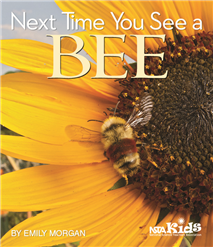Why Are Bees so Buzzworthy? Next Time You See One You’ll Know
By Carole Hayward
Posted on 2019-05-15
 “Bee-Wildering! Hives of Notre-Dame in Miraculous Survival” (Phys.Org): Headlines like this dominate the news lately. They go from wildly hopeful like the Notre Dame story, to speculative [Saving Bees With Sugar: Connecting With Nature or ‘a Last Resort’? (BBC.com)], to downright depressing [Beehive Arson in Texas Kills Half a Million: ‘There Goes My Honey Flow’ (NYTimes.com)]. All the media attention makes for teachable moments about these incredible creatures that are so vital to our environment. But how do you put this all in perspective for young kids?
“Bee-Wildering! Hives of Notre-Dame in Miraculous Survival” (Phys.Org): Headlines like this dominate the news lately. They go from wildly hopeful like the Notre Dame story, to speculative [Saving Bees With Sugar: Connecting With Nature or ‘a Last Resort’? (BBC.com)], to downright depressing [Beehive Arson in Texas Kills Half a Million: ‘There Goes My Honey Flow’ (NYTimes.com)]. All the media attention makes for teachable moments about these incredible creatures that are so vital to our environment. But how do you put this all in perspective for young kids?
Award-winning author Emily Morgan’s new book Next Time You See a Bee is the perfect resource to help children appreciate bees. It’s not meant to be a dry reference, though. Morgan tells readers right up front, “The Next Time You See* books are not meant to present facts to be memorized. They are written to inspire a sense of wonder about ordinary objects or phenomena and foster a desire to learn more about the natural world. Children might initially be afraid of bees. However, when they learn how important bees are to humans and the planet, their fear will hopefully develop into appreciation.”
The book is filled with gorgeous pictures, so even if your students aren’t able to get outside, they can still “experience” the wonder of bees. But if you’re able to follow the author’s recommendations, then do get outside with the kids. Morgan asks readers to watch, find, count, listen, feel, look, touch, observe… but mainly to enjoy and be amazed! Proper cautions are given about being respectful of the bees and to give them enough space. Readers who are fearful of bees are reminded that bees won’t hurt them if left alone.
And yes, the worrisome decline of bee populations is tackled. This is done in an age-appropriate way that addresses the issue, gives vetted science content, and connects readers to their own place in the ecosystem. Simple ideas like planting bee-friendly flowers or using paper tubes to give bees a nesting area will give students a way to be part of the solution (not just for the bees, but for plants, humans, and for all of nature).
Several other pollinators are mentioned, such as butterflies, birds, and wasps, so students get a wider picture of how pollinators and flowers work together. But bees are the most prolific. Once this is established, the author offers information about their bodies and features that make this so.
At one point, Morgan tells us “Bees have no idea how important they are to the plants they visit.” But by the time your students are done reading this charming new title, they will have no doubt as to why!
This book is also available as an ebook.
*Next Time You See a Bee is the newest book in the NSTA Press Next Time You See book series. The series also includes Next Time You See a Sunset, which was named an Outstanding Science Trade Book for Students K–12 and was the winner of the REVERE Award from PreK–12 Learning Group, Association of American Publishers!
Follow NSTA
Disclaimer: The views expressed in this blog post are those of the author(s) and do not necessarily reflect the official position of the National Science Teaching Association (NSTA).


